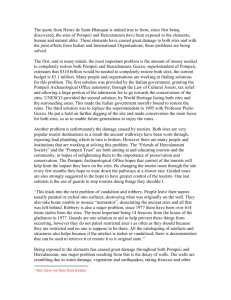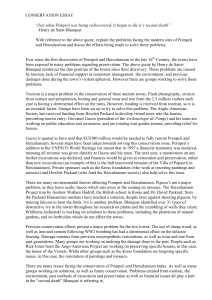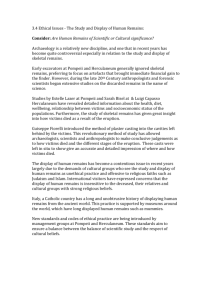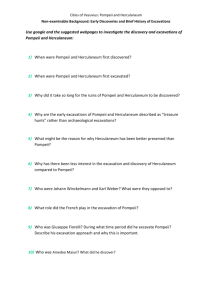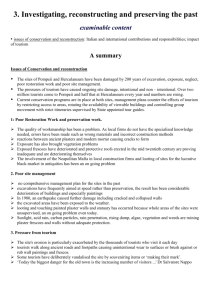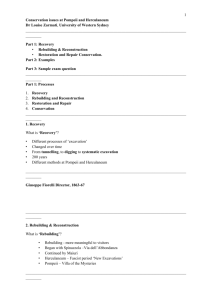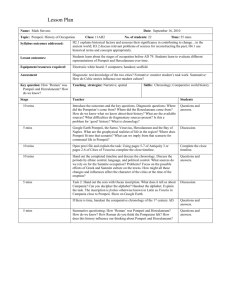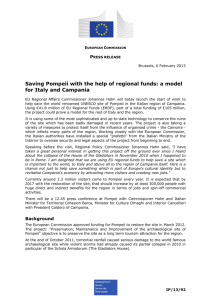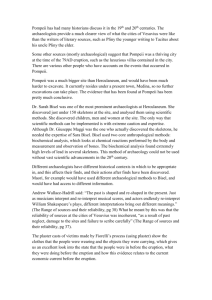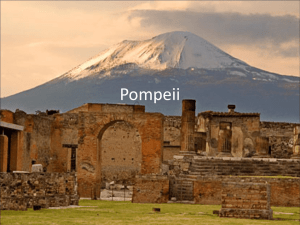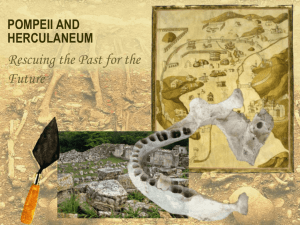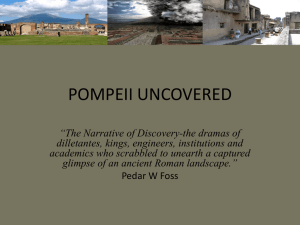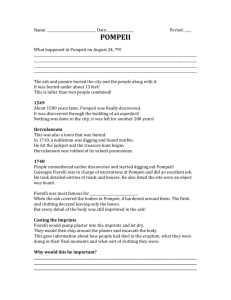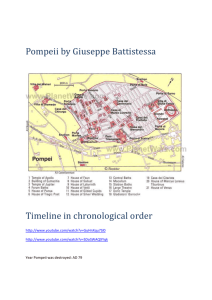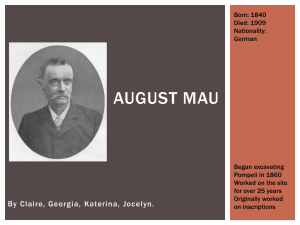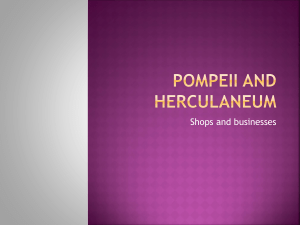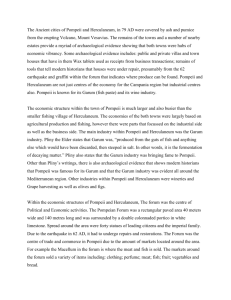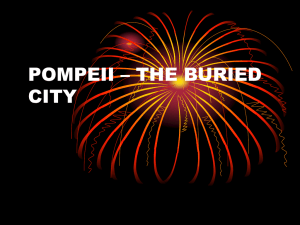Issues of conservation and reconstruction
advertisement
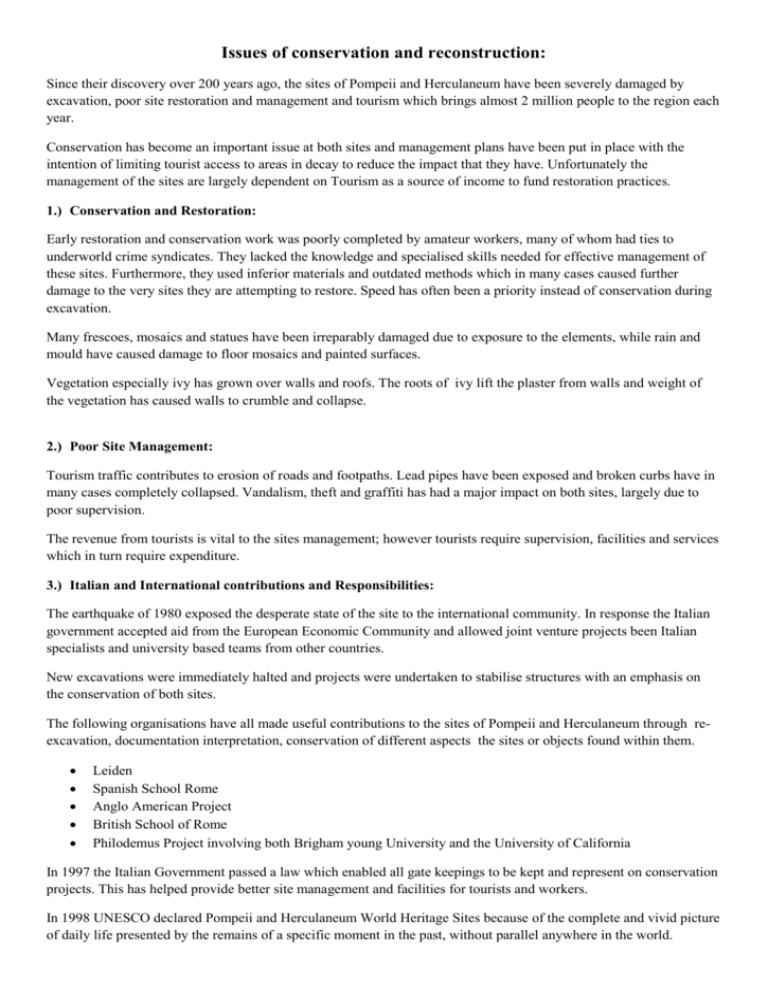
Issues of conservation and reconstruction: Since their discovery over 200 years ago, the sites of Pompeii and Herculaneum have been severely damaged by excavation, poor site restoration and management and tourism which brings almost 2 million people to the region each year. Conservation has become an important issue at both sites and management plans have been put in place with the intention of limiting tourist access to areas in decay to reduce the impact that they have. Unfortunately the management of the sites are largely dependent on Tourism as a source of income to fund restoration practices. 1.) Conservation and Restoration: Early restoration and conservation work was poorly completed by amateur workers, many of whom had ties to underworld crime syndicates. They lacked the knowledge and specialised skills needed for effective management of these sites. Furthermore, they used inferior materials and outdated methods which in many cases caused further damage to the very sites they are attempting to restore. Speed has often been a priority instead of conservation during excavation. Many frescoes, mosaics and statues have been irreparably damaged due to exposure to the elements, while rain and mould have caused damage to floor mosaics and painted surfaces. Vegetation especially ivy has grown over walls and roofs. The roots of ivy lift the plaster from walls and weight of the vegetation has caused walls to crumble and collapse. 2.) Poor Site Management: Tourism traffic contributes to erosion of roads and footpaths. Lead pipes have been exposed and broken curbs have in many cases completely collapsed. Vandalism, theft and graffiti has had a major impact on both sites, largely due to poor supervision. The revenue from tourists is vital to the sites management; however tourists require supervision, facilities and services which in turn require expenditure. 3.) Italian and International contributions and Responsibilities: The earthquake of 1980 exposed the desperate state of the site to the international community. In response the Italian government accepted aid from the European Economic Community and allowed joint venture projects been Italian specialists and university based teams from other countries. New excavations were immediately halted and projects were undertaken to stabilise structures with an emphasis on the conservation of both sites. The following organisations have all made useful contributions to the sites of Pompeii and Herculaneum through reexcavation, documentation interpretation, conservation of different aspects the sites or objects found within them. Leiden Spanish School Rome Anglo American Project British School of Rome Philodemus Project involving both Brigham young University and the University of California In 1997 the Italian Government passed a law which enabled all gate keepings to be kept and represent on conservation projects. This has helped provide better site management and facilities for tourists and workers. In 1998 UNESCO declared Pompeii and Herculaneum World Heritage Sites because of the complete and vivid picture of daily life presented by the remains of a specific moment in the past, without parallel anywhere in the world. The Herculaneum Conservation Project is a good example of international co-operation involving the British School of Rome and the Packard institute, working with Italian archaeologists and other specialists. Management plans have introduced rotational access to sections of the sites to limit tourist traffic in isolated areas by sectioning off insulae for periods of time. Better educational signage and programs also been introduced and the training of guides has been improved. Technology has enabled features of buildings to be carefully photographed, documented and catalogued. Computerised technical and thematic maps have been made of the whole Vesuvian area. From 2003 the process began to move to museums all original pottery, columns, capitals and decoration. They will be replaced on site by reproductions. Ethical Issues: The study and display of human remains. 1.) Study and Research: Fiorelli introduced the method of pouring plaster into the cavities left by the people and animals of Pompeii which made it possible to make conclusions about their death. Skeletal remains have also been found at Pompeii. Originally these bones were ignored by excavators and stored in various buildings around Pompeii in large collections of bones. Estelle Lazer has since examined these skeletal remains using techniques of anthropology and forensic medicine she investigated sex, age, height, signs of disease and the relationship between the victims. Lazer believes that the victims were a good representative sample of the population. The bones show that the people of Pompeii were healthy and well nourished, although their teeth were in bad stages of decay. Evidence of various medical conditions were prevalent in some cases. In Herculaneum the initial 130 skeletons found in the bathhouse were examined by Sara Bisel in the 1980s. She examined the remains to establish levels of health and socio-economic status as well as the cause of death. Many of her findings were highly speculative, especially those about the identity and occupation of individuals. These skeletal remains have been preserved because of the nature of the volcanic deposit which kept them airtight, enabling them to remain in better condition than those at Pompeii. 2.) Display of Human Remains: Italian society has a tradition of displaying the bodies or body parts of saints and martyrs. International museums have also held human remains for research and public display for more than a century. Attitudes began to change during the 20th century over the display of human response due to the demands of indigenous communities. The debate centres over whether human remains were of scientific of cultural significance. Codes of ethics were developed by museums, universities and archaeologists which showed sensitivity to community attitudes and some museums closed exhibitions and returned humans remains to the countries or communities from which they had been removed. In early excavations at Pompeii, human remains were regarded as exhibits for important visitors. Skeletons were often assembled incorrectly in an attempt to show their last moment in life. Fiorelli’s plaster casts were also deemed suitable for exhibition. They were displayed in situ, assembled in groups in new locations or displayed individually in glass cases. Casts have been stored for years among the pots and other artefacts in storerooms off the forum in Pompeii, the most well known being the Muleteer. At Herculaneum, skeletal remains were placed on public display, but replaced with casts for showing. Many international visitors have expressed concern about the way the bodies are displayed and discussions have begun about more sensitive ways of dealing with human remains.
